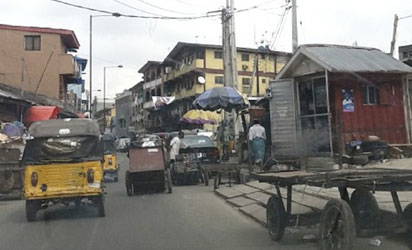Lagos Island, known locally as Èkó, is the cradle of Lagos history. Its streets are not just passageways but living archives — each name, square, and corner whispering stories of migration, trade, resistance, faith, and reinvention. To walk through Èkó is to trace the footsteps of Yoruba settlers, Portuguese and Brazilian returnees, Saro elites, and British administrators whose influences layered the city’s identity.

Commercial & Political Thoroughfares
Broad Street — The commercial backbone of Lagos since the late 19th century. Once home to the Old Secretariat (1890s), General Hospital Odan (1893), and the imposing Broad Street Prison (today’s Freedom Park), it was both a stage for colonial control and a cradle of resistance. Nationalists like Herbert Macaulay and Obafemi Awolowo were imprisoned here, turning Broad Street into a symbol of both oppression and liberation.

Marina Street — Skirting the lagoon, Marina was the front porch of colonial Lagos. Merchant houses, shipping firms, and colonial administrative buildings lined this waterfront, which also symbolized Lagos as a port city where the world arrived by sea.
Tinubu Square — Formerly Independence Square, renamed after Madam Efunroye Tinubu, the formidable 19th-century trader and political matriarch. Centrally placed, the square has long been a gathering point for commerce, protest, and civic life.

Campbell Street — Named after Robert Campbell, Jamaican educator and publisher of the Anglo-African newspaper. Over time, it became known for its schools, government offices, and now the Campbell Centre, showing the street’s continuous reinvention.
Nnamdi Azikiwe Street (formerly Queens Street) — Renamed after Nigeria’s first President, it reflects nationalist pride. Its shops, banks, and eateries hum with the vibrancy of Lagos commerce.

Idumota & Balogun Market — Together, they form the restless pulse of Lagos trading. Idumota became synonymous with bookshops, music distribution, and Nollywood’s early economy, while Balogun evolved into one of West Africa’s largest markets for textiles and household goods.
Returnee Quarters & Heritage Streets
Olowogbowo / Breadfruit — Settlement of the Saros (Sierra Leone returnees, liberated Africans resettled in Lagos). They brought Western education, clerical professions, and a cosmopolitan outlook that shaped Lagos’ middle class.
Oke-Popo / Campos (Brazilian Quarters) — Home of the Aguda returnees from Brazil. Campos Square still bears their legacy: stucco-fronted Brazilian houses, arched windows, Catholic processions, and courtyards that once echoed with samba rhythms and Yoruba chants.
Lafiaji / Okesuna — Linked to Portuguese returnees. Early Catholic churches and Afro-Portuguese families thrived here, adding to the Island’s multi-ethnic texture.
Idumagbo Avenue — Born after the river between Idumagbo and Oko-Faji was filled. Its name means “quarters of the elites”, highlighting the status of those who resided there. Today, it is a bridge between schools, markets, and civic institutions.
Okepopo Street — Named after the Okepopo River that once flowed nearby, it preserves the Island’s memory of waterways that shaped settlement.
Kakawa Street — A 19th-century lane tied to early Lagos publishing and trade. Its name recalls agricultural roots, while its history connects to the world of communication and printing.
Ereko Street — Famous for textiles, fashion, and trade, Ereko has been a market corridor for centuries.
Colonial & Ceremonial Roads
King George V Road (Onikan) — Built as a ceremonial boulevard. It links the old Race Course (now Tafawa Balewa Square), colonial offices, and today’s National Museum. In its heyday, it was the parade ground of empire; today, it remains central to Lagos’ civic life.
Moloney Street — Named after Governor Sir William Moloney, this street connects Broad Street to Onikan. Its placement reflects colonial town planning designed to enforce order and authority.
Catholic Mission Street — A landmark of faith and education. The Holy Cross Cathedral, seat of the Catholic Archdiocese of Lagos, stands here, surrounded by schools and mission houses.
Residential Arteries & Expansions
Adeniji Adele Road — Named after an Oba of Lagos, this road bridges the old quarters with expanding residential districts. Its landscape tells of colonial-era bungalows sitting alongside modern high-rises.
Ikoyi Road — The link between Isale Eko and the exclusive suburb of Ikoyi. In colonial times it was reserved for Europeans; post-independence, it became home to elites and diplomats, marking Lagos’ evolution from Island nucleus to metropolitan sprawl.
Odunlami & Martins Streets — Known for nightlife, street food, fabrics, and household items. These lanes keep Lagos’ reputation as a city that never sleeps.
Icons & Landmarks Embedded in the Streets
Freedom Park (Old Broad Street Prison) — A site of memory, once a colonial prison, now reborn as a cultural park where music, arts, and public discourse thrive.
General Hospital, Odan — Established in 1893, one of Nigeria’s oldest hospitals, a colonial institution turned national legacy.
Christ Church Cathedral — Founded in 1869, seat of the Anglican bishop, burial place of Bishop Samuel Ajayi Crowther, the first African Anglican bishop.
First Baptist Church & Lagos Baptist Academy — Testament to the missionary and educational history of Lagos.
Conclusion
The streets of Èkó are not simply routes for traffic; they are the pages of a living book. From the Brazilian courtyards of Campos to the bustling stalls of Idumota, from the colonial pomp of King George V Road to the nationalist spirit of Nnamdi Azikiwe Street, Lagos Island embodies the meeting of worlds — Yoruba, Portuguese, Brazilian, Saro, and British.
Every street is a thread in the tapestry of Lagos, reminding us that this city was never just built — it was woven, contested, and constantly reinvented.
Source:
Cicero Adegboyega Ademide Sasore-Whyte.




